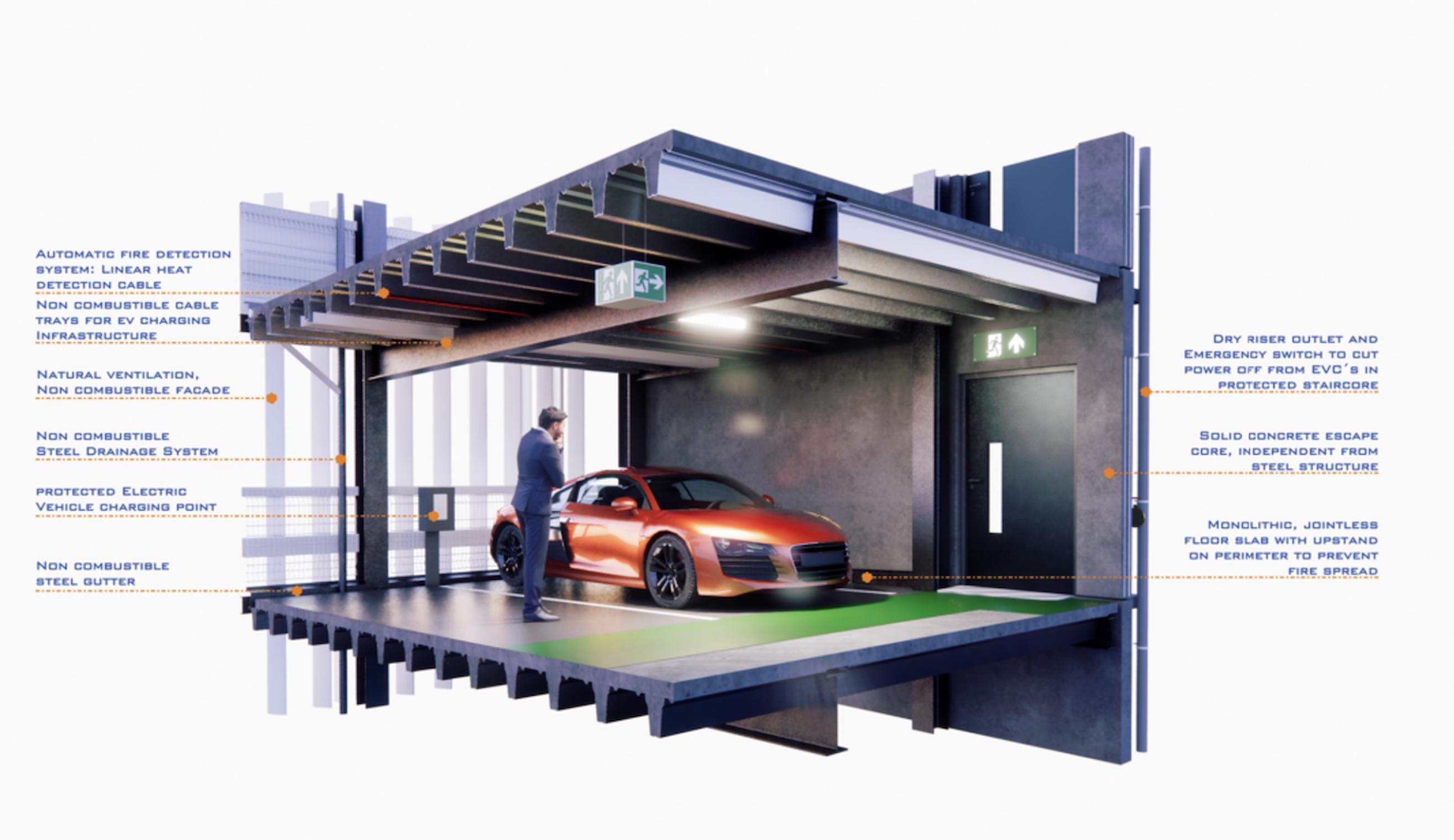

To date, it has generally been assumed that the fire load and the risk of a car park fire spreading significantly are relatively low. However, recent technological changes and serious car park fires have challenged these assumptions, and car park designs have been questioned with regards to adequate fire safety. The following article addresses the current UK legislative framework, recent major car park fires, technological changes, such as electric vehicles (EVs), and recommendations for the design of open-sided multi-storey car parks (MSCPs).
The UK legislative framework for fire safety design is underpinned by five separate ‘Functional Requirements’; each designed to safeguard against the loss of life, should fire occur. Measures to prevent property losses, content losses, or business downtime are not usually explicitly considered and more a concern of the building’s end user or insurer. Generally, each “life safety” requirement is achieved if the fire safety guidance has been satisfied; reference to fire safety engineering techniques would be less common.
The Building Regulations 2010, Approved Document B (Fire Safety), states that”the fire load [of car parks] is well defined” and “the probability of fire spreading from one storey to another in a well-ventilated car park is low”. These statements are partly based on the published results of car park fire tests in the past, which claimed that there is low fuel load and fire spread probability in car parks. This may be one of the main reasons why few, if any, well-ventilated car park structures have been installed with sprinkler protection, and why many are supported by a structure which has the lowest fire resistance period stipulated (i.e., 15 minutes).
Recent major fires in multi-storey car parks, such as the Stavanger Airport fire (Norway, 2020) with more than 300 cars destroyed, and the Liverpool Kings Dock fire (UK, 2017) with around 1,150 cars destroyed, have raised concerns about car park fire safety. In both cases, there was no automatic fire detection connected with the alarm system. Additionally, car park users did not alert firefighting services immediately. These factors resulted in the firefighting services only starting operations 27 minutes (Stavanger) and 22 minutes (Liverpool) later. The Merseyside Fire & Rescue Service’s report suggested that the Liverpool Kings Dock fire spread vertically to all other levels via the combustible drainage system and floor joints, describing the ignited fuel running down as “waterfalls of fire”.
A fire in the Cork shopping centre multi-storey car park (Ireland, 2019) had relatively milder consequences in that ‘only’ 60 cars were damaged. The assumption is that this is due to the continuous composite decking system (monolithic slab) which was used to form the floor structure of the car park. As this system is jointless, the ability for the fire to spread between floors would have been restricted. It is important to note that no fatalities or serious injuries were reported in all three of the car park fires discussed in this article, even where significant structural collapse occurred due to fire. Therefore, with respect to the protection of life, it could be said that each of these buildings performed adequately when exposed to fire.
A further consideration with regards to fire safety is the rapid technological changes in the car industry, particularly in the past decades. These include greater use of composites for the body of vehicles, increased vehicle sizes, and alternative fuel types. Recent research published by the Fire Protection Research Foundation has demonstrated both that modern cars of the 2010s contain 91% more plastic than cars of the 1970s (the plastic content of modern cars still makes up less than 10% of the total vehicle kerb weight), and that although many vehicle sizes have increased, there is no significant difference between the peak heat release rates (HRRs) of modern (2010s) and older (1980s) car fires.
Significantly, the rising popularity of electric vehicles (EVs) raises fire safety concerns amongst many in the industry. Many of these concerns stem from a lack of EV fire data, knowledge and experience, as the majority of existing data for car fires comes from fire tests conducted using, and real fires involving, internal combustion engine vehicles (ICEVs). Several studies on EV fires show that the maximum fire size (heat release rate) of a burning EV is similar to that of an ICEV. The main contribution to the heat release rate was due to conventional materials found in a vehicle, rather than lithium-ion battery (LiB) packs.
It has further been claimed that EV fires can continue for longer; and if the LiB pack is involved, it can produce jet flames which could accelerate fire spread. An additional consideration are the LiB packs in electrical vehicles whereby, should they be damaged or malfunction, they can undergo thermal runaway (where a battery, at first, slowly increases in temperature and then undergoes a rapid chemical, exothermic heat reaction resulting in ignition of the battery up to several hours after the initial temperature increase). The risk here is that thermal runaway can remain undetected for long periods of time and can cause unexpected explosions. Additionally, fires involving EVs can reignite and self-ignite, but there does not seem to be adequate research on this to-date.
Importantly, some studies suggest that the consequences of a LiB pack igniting would likely occur long after evacuation has taken place. So, although these phenomena may cause increased risk to fire service personnel, should they arrive at a later stage of the fire, it is unlikely they would affect the safety of general car park users. It is also claimed that EV fires produce a larger quantity of toxic gases, such as hydrogen fluoride, and metals, than traditional ICEV fires. However, recent research has concluded that the total quantity of hydrogen fluoride may be lower than expected; meaning the effect of metals could be considered more of an environmental issue rather than a life safety issue.
In summary, advances in car design may have changed the fire risk in a multi storey car park but there has not yet been sufficient research to determine whether changes in fire safety measures are required and what they may be. We believe further fire tests will likely provide more data to better understand the risks associated with EVs, and consequently help inform relevant design and risk management. This will in turn allow fire services to develop a better understanding of how to deal with car park fires; particularly, with regards the extinguishing of LiB fires in buildings.
In reaction to the above, there are growing requests within the industry that car park structures should be designed with longer fire resistance periods. These demands are based on the assumption that the longer period would inevitably lead to a “safer” building. However, it is our belief that increasing fire resistance is not necessarily the most appropriate or practicable solution to ensure safety. The overall building design and its structure must be taken into consideration. In essence, all fire safety measures must be considered holistically as part of a building’s fire safety strategy.
HUBER Car Park Systems shares its expertise and design experience
Taking into account current available data and experience, HUBER Car Park Systems believes the following recommendations should be part of a fire safety strategy when designing a bespoke open-sided multi-storey car park.
For a visual understanding of how these can work cohesively as part of a building’s fire strategy, please see the graphic above.
This article was produced by Malika Alimzhanova and Shami Smith-Sandhu of Semper Fire Engineering, and Marco Reifert and Merle Kurz of HUBER Car Park Systems
For more technical and in-depth information and/or details of any of the sources used contact:
info@huber-carparksystems.com

TransportXtra is part of Landor LINKS
© 2025 TransportXtra | Landor LINKS Ltd | All Rights Reserved
Subscriptions, Magazines & Online Access Enquires
[Frequently Asked Questions]
Email: subs.ltt@landor.co.uk | Tel: +44 (0) 20 7091 7959
Shop & Accounts Enquires
Email: accounts@landor.co.uk | Tel: +44 (0) 20 7091 7855
Advertising Sales & Recruitment Enquires
Email: daniel@landor.co.uk | Tel: +44 (0) 20 7091 7861
Events & Conference Enquires
Email: conferences@landor.co.uk | Tel: +44 (0) 20 7091 7865
Press Releases & Editorial Enquires
Email: info@transportxtra.com | Tel: +44 (0) 20 7091 7875
Privacy Policy | Terms and Conditions | Advertise
Web design london by Brainiac Media 2020